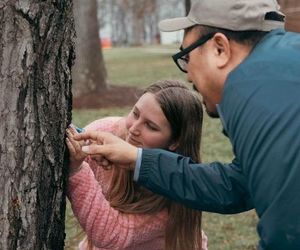
It’s an uncommon sight in this part of the country, but since winter of 2018, Dr. Jay Bolin, Dean of Natural Sciences, and his students have brought “Maple Days” to campus. Most years, that is: weather is the determining factor. “Last year we didn’t do it,” amends Dr. Bolin, “the weather was too warm.” Students in Dr. Bolin’s biology class, Ecology and Evolution, use the collected sap to make maple syrup. The students’ lab work in the course also includes measuring sugar content of sap from the sugar maples using a Brix refractometer and comparing it with other maple varieties, including red, silver, and Japanese maples. Students in this year’s class also studied the ecology of birds and insects attracted to the sap as a food source. Several yellow-bellied sapsuckers were seen this year, and it is the name of an actual bird, students learned, not just what Grandpa called politicians when he was upset.
The weather necessary for sugaring in our state is limited primarily to Western North Carolina, but conditions there are still unreliable. Consistent below freezing temperatures at night with above freezing temperatures during the day are best. Dr. Bolin explains that is the reason there is no major sugaring industry in this area. In this climate, sugar maples don’t do well long-term, and the sugar maples planted on campus are not native to our piedmont. Commenting on this unusual class project, student Makayla Davis remarks wryly, “North Carolina doesn’t really scream ‘maple syrup’, but here we are.”
Dr. Bolin and his twenty-four students cover a lot of ground as they tap trees around campus and in the Fred Stanback, Jr. Ecological Preserve, empty the buckets every day and take the gathered sap to store in a lab refrigerator. Daily rounds are necessary; sap left in the buckets begins to ferment.
Until this year, Dr. Bolin used makeshift plastic tubing that fed into repurposed gallon milk jugs sitting at the base of the trees. Funds for the purchase of fermentation lab equipment allowed him to obtain genuine sap buckets and spiles (taps). This year, the class mounted fourteen brand-new lidded plastic sap buckets directly on plastic spiles they tapped carefully into the tree trunks. That is one of Dr. Bolin’s favorite parts of the process, “I really like the expressions on students’ faces when they tap the tree and pound in the spile for the first time, and the sap just starts flowing like magic, it’s really a priceless moment.”
It takes forty gallons of sap to make one gallon of syrup, which helps explain the price of authentic maple syrup. In past years, Dr. Bolin’s classes collected sap enough to make about a pint of syrup; this year they managed to collect enough to net a quart. The boiling process to reduce sap to syrup takes an entire day or longer. “There’s not much excitement in that part,” Dr. Bolin remarks. He is excited, however, about using the new Food and Fermentation laboratory in the process this year. “Previously we had to do all the boiling outside, which had its own charm, but in the new lab it’s so much easier to have the students do the technical aspects, such as measuring the sugar content.”
There are sweet rewards for their work: the tasting. Student Dylan Cienfuegos notices the syrup is not as thick as he thought it would be. Classmate Carter Mayhew thinks it compares to store bought. Student Cole Johnson admits, “I was not actually expecting it to taste like maple syrup,” adding that it has a good aftertaste.
Hannah Wagenaar offers a unique perspective, “Being a business major, science is unfamiliar to me. Making syrup has been interesting and exciting. Since coming to the US from South Africa, I have loved eating maple syrup, so this has been cool.” Callie Trexler best sums up the students’ overall impressions, exclaiming, “It was yummy!”
